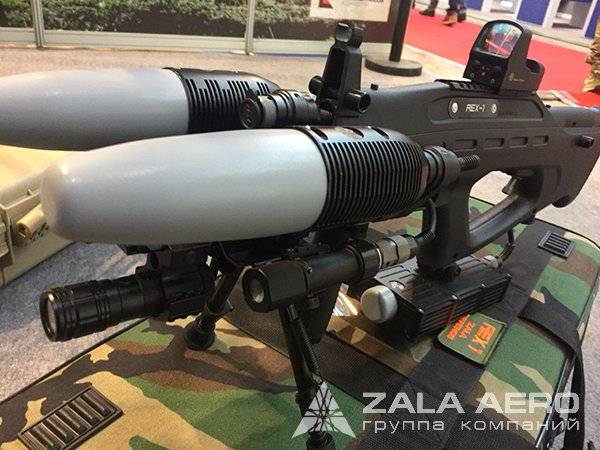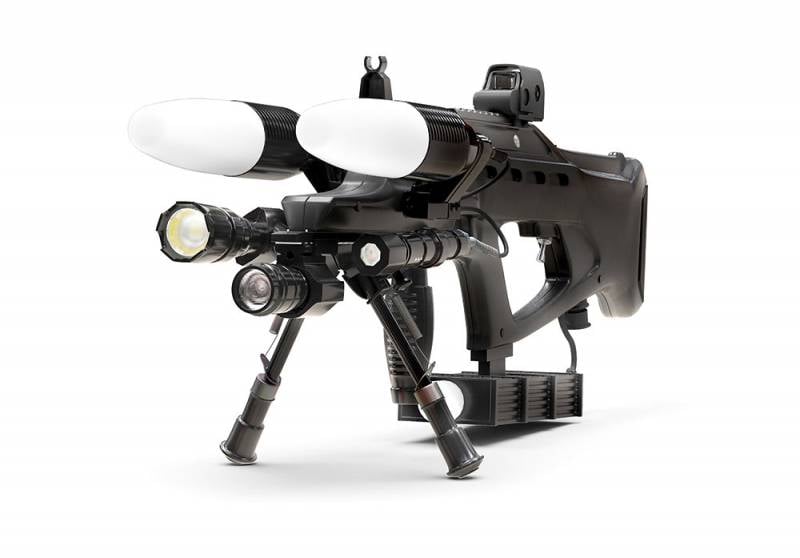Combat against UAV REX-1
Unmanned aerial vehicles of light and medium class can be used to solve various tasks and therefore can pose a threat to important objects. Accordingly, in order to protect against drones specialized electronic warfare systems are needed. Similar equipment is already being created in our country and abroad. To date, this direction has managed to show some success. A curious representative of an important class of specialized systems is the domestic complex REX-1.
A promising portable electronic warfare system for work on UAVs was first introduced in August 2017 of the year at the international military-technical forum "Army". The REX-1 product was developed by Zala Aero Group Unmanned Systems, which is part of the Kalashnikov Concern. At the time of the first public demonstration, the complex was ready for operation and could be used for its intended purpose. New development in the field of EW naturally attracted the attention of specialists and the public.
Later, the company-developer several times demonstrated its promising complex to the press, and also brought it to new exhibitions. Thus, within the framework of the Army-2018 forum, an updated version of the system was presented, refined according to the results of tests and checks. In the course of the modernization, the product configuration was changed, due to which it was possible to expand the range of tasks to be solved. In addition, the appearance of the system has significantly changed. The previously existing units now have other lines and are complemented by new devices. At the same time, despite all the improvements, the overall architecture of the complex remained without significant changes.
Last year, it was claimed that the REX-1 UAV anti-aircraft complex was developed by Zala on its own initiative. On the design work spent just a month. The work was accelerated through the use of correct approaches. The design of the complex uses some ready-made components of one kind or another, including recognizable ones. Unfortunately, at that time it was not possible to manage only with the domestic component base, and foreign components included in the electronic equipment. However, the presence of imported components is justified by the results.
The REX-1 complex is made in the form factor of a rifle / assault rifle with a bullpup layout - if such terminology is applicable to electronic equipment. Such an arrangement is defined by the base component of the product, borrowed from an existing sports sample. weapons. All electronic components are mounted on a plastic bed taken from an air rifle MP-514K. The latter is known for its unusual appearance and is well known to all lovers of sports and recreational shooting. The lodge of sports weapons was considered suitable for use in a special project.
The box loses all the regular components, instead of which the new equipment is installed. The front part of the box, previously supporting the muzzle segment, is now intended to install a set of radiating antennas and other means of influence on the target. Inside the box are electronic control devices and the formation of radio signals. Also in the plastic case fits its own battery, supplemented by a connector for connecting external power.

Last year, the exhibition sample of the REX-1 system had box-shaped radiators with trapezoidal radio-transparent covers. Next to them were other antennas, lights, etc. A characteristic feature of the complex was the external placement of antenna devices, as a result of which they were connected to the internal equipment of the box using unprotected cables and external connectors.
The 2018 wrestling complex of the year is distinguished by the shape of the main units and the methods of their fastening. In particular, now the antennas are mounted on brackets of a new design, ensuring their correct position and aiming at the target. Actually antenna devices now have a round section. The bodies themselves are reduced, while the size of the radio transparent covers is increased. It also provides for the installation of three additional devices operating in the radio and optical bands.
All modules of the REX-1 complex have their own purpose, and each of them is responsible for solving a specific problem. The modular design principle facilitates the repair and modernization of the system. The damaged module can be quickly and easily removed from the box, replacing the new one. Upgrades can be done in a similar way. A set of modules allows you to influence the target in several ways at once, preventing its effective operation.
The complex is proposed to be used against unmanned aerial vehicles of the light and middle class. This technique uses radio control and telemetry operating at known frequencies. Two modules are designed to suppress communication channels operating at 2,4 and 5,8 GHz. Directional antennas of these modules block the operation of the communication means of the drone. The suppression of the radio channel of communication with the operator, depending on the type and model of the target, makes it difficult or impossible to continue its work. Also directional antennas can operate in other bands, including those used in civilian communications.
The third module of the REX-1 complex emits interference at frequencies used by satellite navigation systems. When using this device, the UAV loses the ability to accurately determine its location. The loss of communication with the console and the inability to navigate does not allow most modern UAVs to continue working. The most likely outcome of the use of three modules of electronic warfare is the landing or falling of the aircraft.
Also, the project of the company Zala Aero Group provides for the use of optical-electronic suppression. With their help, the REX-1 complex is capable of affecting optical instruments of a target, hindering their operation. There are two ways to influence the target with the help of light and optical signals.
The first opto-electronic module is based on a high-power flashlight with a strobe function. Bright flashing light can negatively affect the UAV camera and interfere with the work of its operator, who receives the video signal on the console screen. For the same purpose, the second module is used, which includes the laser of the optical range. The directional beam should give a flare and exclude the normal operation of the camera. Some laser complexes of optoelectronic suppression are characterized by high power and are capable of disabling or damaging optical devices. Whether such functions have REX-1 is not specified.
From the point of view of ergonomics, the complex for dealing with UAVs is similar to small arms. The plastic box has an integrated pistol grip, connected with a shoulder rest using a longitudinal strap. For greater convenience of retention provides for the use of a "tactical" front handle mounted on the Picatinny rail. Next to it is set folding bipod. For carrying it is proposed to use a belt with two attachment points. Control is carried out using several switches. One of them is on the site of the trigger.
Guidance of the complex on the drone-target is made using a gun-type sight. Prototypes, shown in 2017 and 2018, carried collimator sights of various models. Homing REX-1 is simplified due to the fact that radio-electronic and optical modules emit a signal in a certain sector. More accurate guidance is needed only when using a laser.
The REX-1 complex in working condition has a length of 700 mm with a height of 240 mm and a maximum height of 160 mm. Weight - total 4,5 kg. A hard case is used to transport the product. The built-in battery ensures uninterrupted operation for 3 hours and is capable of storing a charge of 36 months. If necessary, you can use an external power supply, which practically does not limit the time of work.
According to the developer, analog radio signals are suppressed using a directional antenna in a sector of width 30 °. Suppression range - 500 m. Directional suppression of cellular signals or Wi-Fi is provided at ranges up to 1 km. The satellite navigation system signal suppression module provides a circular cover and operates within a radius of 2 km. It is important that when operating the complex does not have a significant impact on the operator. In terms of electromagnetic exposure, REX-1 per person is like a pair of working smartphones.
The complex of fight against the UAV Zala REX-1 intends, first of all, for army and power structures. Army units, structures of the Ministry of the Interior, etc. can receive the task of preventing the access of the UAV to the specified zones. Complexes like the REX-1 are capable of eliminating the passage of drones without any risks to the infrastructure, people or the environment. Electronic or optical impact on the target "gently" prevents its effective operation and does not allow the enemy to solve their problems.
The possibility of supplying new complexes to foreign customers is not excluded. In August, it was reported that REX-1 passed the necessary checks and received a security certificate for export. The possibility of selling new systems to individuals and organizations was also mentioned. However, a complete set of devices is intended only for the military and security forces. Civilian customers will have to use the equipment in a reduced configuration and with fewer functions.
The REX-1 complex has already passed the necessary tests, and it has been verified by both specialists of the Zala Aero Group and the military. At the end of September, it was reported that during the international exercises "Vostok-2018" Russian fighters tested the latest means to fight drones at the test site. It is possible that the Ministry of Defense, after examining the results of recent exercises, will decide on the launch of a new complex.
***
It should be noted that the fact of developing a new complex to counter unmanned aerial vehicles can no longer be loud news. The similar equipment is created in the different countries, and some foreign samples managed to enter the market. Thus, each new development of this kind, including the Russian complex REX-1, becomes only another example of its class.

Based on the available data, it can be assumed that Zala's REX-1 product is indeed of interest to potential customers. Unlike a number of analogs of domestic and foreign production, REX-1 affects not only radio channels, but also optical target devices. This clearly affects the performance of the UAV. In addition, there is the possibility of exposure to other goals. For example, a strobe or laser can be used against any video system or manpower.
REX-1 has a very good ergonomics, and in addition, based on the finished components. Extreme simplicity of operation is declared: preparation for work and “shooting” at the target. All these factors can be an advantage over competing products and affect the commercial potential of the project. Information on orders and deliveries is not yet available, but there is every reason to expect that contracts for serial devices will appear in the near future.
According to various estimates, the Russian defense industry is the world leader in the field of electronic warfare. Practice confirms these estimates, and also indicates the fact that new successful developments are present in all major areas. Russian enterprises are capable of building not only large EW military complexes, but also compact specialized systems.
On the materials of the sites:
http://zala.aero/
http://rostec.ru/
https://rg.ru/
http://tass.ru/
http://iz.ru/



Information